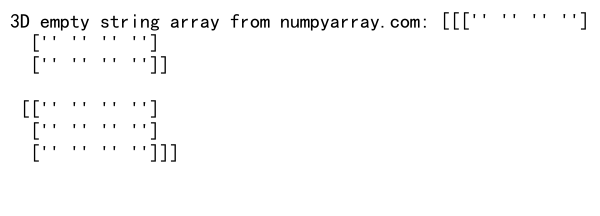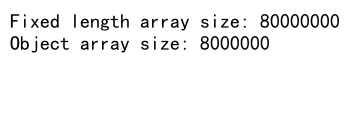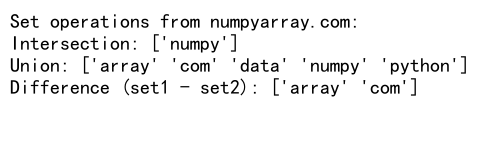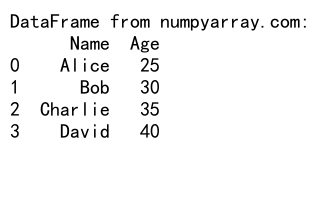NumPy创建空字符串数组:全面指南与实用示例
参考:numpy empty array of strings
NumPy是Python中用于科学计算的核心库,它提供了高性能的多维数组对象和用于处理这些数组的工具。在处理文本数据时,创建空的字符串数组是一个常见的需求。本文将详细介绍如何使用NumPy创建空的字符串数组,并提供多个实用示例来帮助您更好地理解和应用这一技术。
1. 理解NumPy中的字符串数组
在NumPy中,字符串被视为一种特殊的数据类型。与数值类型不同,字符串是可变长度的,这使得它们在内存中的处理方式有所不同。NumPy提供了几种方法来创建和操作字符串数组,其中最常用的是dtype=object和固定长度的Unicode字符串。
1.1 使用dtype=object创建空字符串数组
使用dtype=object是创建可变长度字符串数组的最灵活方法。这种方法允许每个元素存储不同长度的字符串。
import numpy as np
# 创建一个1维的空字符串数组
empty_str_array = np.empty(5, dtype=object)
print("Empty string array from numpyarray.com:", empty_str_array)
Output:

这段代码创建了一个包含5个元素的一维数组,每个元素都是一个Python对象,可以存储任意长度的字符串。
1.2 使用固定长度的Unicode字符串
对于固定长度的字符串,我们可以使用dtype='U<n>',其中<n>是字符串的最大长度。
import numpy as np
# 创建一个2x3的空字符串数组,每个字符串最多10个字符
empty_fixed_str_array = np.empty((2, 3), dtype='U10')
print("Fixed-length empty string array from numpyarray.com:", empty_fixed_str_array)
Output:

这个例子创建了一个2行3列的数组,每个元素都是最多可以存储10个Unicode字符的字符串。
2. 创建多维空字符串数组
NumPy的强大之处在于它可以轻松创建多维数组。让我们看看如何创建不同维度的空字符串数组。
2.1 创建二维空字符串数组
import numpy as np
# 创建一个3x4的空字符串数组
empty_2d_array = np.empty((3, 4), dtype=object)
print("2D empty string array from numpyarray.com:", empty_2d_array)
Output:

这个例子创建了一个3行4列的二维数组,每个元素都是一个可以存储任意长度字符串的对象。
2.2 创建三维空字符串数组
import numpy as np
# 创建一个2x3x4的空字符串数组
empty_3d_array = np.empty((2, 3, 4), dtype='U15')
print("3D empty string array from numpyarray.com:", empty_3d_array)
Output:

这个例子创建了一个2x3x4的三维数组,每个元素都是一个最多可以存储15个Unicode字符的字符串。
3. 初始化空字符串数组
创建空字符串数组后,通常需要用实际的字符串值来初始化它。这里有几种常用的方法。
3.1 使用循环初始化
import numpy as np
empty_array = np.empty(5, dtype=object)
for i in range(5):
empty_array[i] = f"numpyarray.com string {i}"
print("Initialized array:", empty_array)
Output:

这个例子展示了如何使用循环来逐个初始化数组元素。
3.2 使用列表推导式初始化
import numpy as np
initialized_array = np.array([f"numpyarray.com item {i}" for i in range(5)], dtype=object)
print("Array initialized with list comprehension:", initialized_array)
Output:

这个方法使用列表推导式来创建一个已初始化的数组,更加简洁高效。
4. 操作字符串数组
创建空字符串数组后,我们经常需要对其进行各种操作。以下是一些常见的操作示例。
4.1 连接字符串数组
import numpy as np
arr1 = np.array(['numpyarray', 'com'], dtype=object)
arr2 = np.array(['is', 'awesome'], dtype=object)
combined = np.char.add(arr1, arr2)
print("Combined array from numpyarray.com:", combined)
这个例子展示了如何使用np.char.add()函数来连接两个字符串数组。
4.2 重复字符串
import numpy as np
str_array = np.array(['numpyarray.com '], dtype=object)
repeated = np.char.multiply(str_array, 3)
print("Repeated string from numpyarray.com:", repeated)
这个例子使用np.char.multiply()函数来重复字符串数组中的元素。
4.3 字符串大小写转换
import numpy as np
mixed_case = np.array(['NumPyArray.com', 'NUMPY', 'array'], dtype=object)
upper_case = np.char.upper(mixed_case)
lower_case = np.char.lower(mixed_case)
print("Upper case from numpyarray.com:", upper_case)
print("Lower case from numpyarray.com:", lower_case)
这个例子展示了如何使用np.char.upper()和np.char.lower()函数来转换字符串数组的大小写。
5. 高级字符串数组操作
除了基本操作,NumPy还提供了一些高级的字符串数组操作方法。
5.1 字符串拆分
import numpy as np
sentences = np.array(['numpyarray.com is great', 'numpy arrays are fast'], dtype=object)
words = np.char.split(sentences)
print("Split words from numpyarray.com:", words)
这个例子使用np.char.split()函数来将句子拆分成单词数组。
5.2 字符串替换
import numpy as np
text = np.array(['numpyarray.com is awesome', 'numpyarray.com is fast'], dtype=object)
replaced = np.char.replace(text, 'numpyarray.com', 'NumPy')
print("Replaced text from numpyarray.com:", replaced)
这个例子展示了如何使用np.char.replace()函数来替换字符串数组中的特定子字符串。
5.3 字符串查找
import numpy as np
haystack = np.array(['numpyarray.com is great', 'numpy is powerful', 'arrays are fast'], dtype=object)
needle = 'numpy'
found = np.char.find(haystack, needle)
print("Found indices from numpyarray.com:", found)
这个例子使用np.char.find()函数来在字符串数组中查找特定子字符串的位置。
6. 字符串数组的性能优化
在处理大型字符串数组时,性能是一个重要考虑因素。以下是一些优化技巧。
6.1 使用固定长度字符串
import numpy as np
# 使用固定长度字符串
fixed_length = np.empty(1000000, dtype='U20')
fixed_length[:] = 'numpyarray.com'
# 使用对象数组
object_array = np.empty(1000000, dtype=object)
object_array[:] = 'numpyarray.com'
print("Fixed length array size:", fixed_length.nbytes)
print("Object array size:", object_array.nbytes)
Output:

这个例子比较了固定长度字符串数组和对象数组的内存使用。通常,固定长度字符串数组在内存使用和处理速度上更有效率。
6.2 向量化操作
import numpy as np
# 创建一个大型字符串数组
large_array = np.array(['numpyarray.com'] * 1000000, dtype=object)
# 向量化操作
uppercase = np.char.upper(large_array)
print("Vectorized operation completed on numpyarray.com data")
这个例子展示了如何使用NumPy的向量化操作来高效处理大型字符串数组。
7. 字符串数组的应用场景
字符串数组在数据处理和分析中有广泛的应用。以下是一些常见的应用场景。
7.1 文本数据预处理
import numpy as np
# 模拟一些文本数据
texts = np.array([' numpyarray.com ', 'NUMPY IS GREAT', 'arrays are fast '], dtype=object)
# 预处理:去除空白和统一大小写
processed = np.char.strip(np.char.lower(texts))
print("Processed text from numpyarray.com:", processed)
这个例子展示了如何使用NumPy的字符串函数来预处理文本数据,包括去除空白和统一大小写。
7.2 简单的文本分析
import numpy as np
# 模拟一些句子
sentences = np.array([
'numpyarray.com is a great resource',
'numpy makes array operations easy',
'python and numpy work well together'
], dtype=object)
# 计算每个句子的单词数
word_counts = np.char.count(sentences, ' ') + 1
print("Word counts from numpyarray.com:", word_counts)
这个例子展示了如何使用NumPy的字符串函数来进行简单的文本分析,如计算句子中的单词数。
8. 字符串数组与其他NumPy功能的结合
字符串数组可以与NumPy的其他功能结合使用,以实现更复杂的数据处理任务。
8.1 使用布尔索引
import numpy as np
# 创建一个字符串数组
fruits = np.array(['apple', 'banana', 'cherry', 'date', 'elderberry'], dtype=object)
# 使用布尔索引选择长度大于5的水果
long_fruits = fruits[np.char.str_len(fruits) > 5]
print("Long fruits from numpyarray.com:", long_fruits)
这个例子展示了如何使用布尔索引和np.char.str_len()函数来选择长度超过特定值的字符串。
8.2 结合数值数组
import numpy as np
# 创建一个字符串数组和一个对应的数值数组
products = np.array(['numpyarray.com t-shirt', 'numpy mug', 'python book'], dtype=object)
prices = np.array([20.0, 10.0, 30.0])
# 创建一个格式化的价格标签数组
price_labels = np.char.add(products, np.char.add(' - $', prices.astype(str)))
print("Price labels from numpyarray.com:", price_labels)
这个例子展示了如何将字符串数组与数值数组结合,创建格式化的价格标签。
9. 处理缺失值和特殊字符
在实际应用中,我们经常需要处理包含缺失值或特殊字符的字符串数组。
9.1 处理缺失值
import numpy as np
# 创建一个包含缺失值的字符串数组
data = np.array(['apple', 'banana', '', None, 'cherry'], dtype=object)
# 将空字符串和None替换为'Unknown'
cleaned_data = np.where(data.astype(bool), data, 'Unknown')
print("Cleaned data from numpyarray.com:", cleaned_data)
Output:

这个例子展示了如何处理字符串数组中的缺失值,将空字符串和None替换为一个默认值。
9.2 处理特殊字符
import numpy as np
# 创建一个包含特殊字符的字符串数组
text = np.array(['numpyarray.com!', 'numpy@array', 'array#numpy'], dtype=object)
# 移除特殊字符
cleaned_text = np.char.replace(text, r'[!@#$%^&*()]', '')
print("Cleaned text from numpyarray.com:", cleaned_text)
这个例子展示了如何使用np.char.replace()函数来移除字符串中的特殊字符。
10. 字符串数组的序列化和反序列化
在处理大型数据集时,我们可能需要将字符串数组保存到文件或从文件中加载。
10.1 保存字符串数组到文件
import numpy as np
# 创建一个字符串数组
data = np.array(['numpyarray.com', 'is', 'awesome'], dtype=object)
# 保存到文件
np.save('numpyarray_com_data.npy', data)
print("Data saved to file from numpyarray.com")
Output:

这个例子展示了如何使用np.save()函数将字符串数组保存到文件。
10.2 从文件加载字符串数组
import numpy as np
# 从文件加载字符串数组
loaded_data = np.load('numpyarray_com_data.npy', allow_pickle=True)
print("Loaded data from numpyarray.com:", loaded_data)
Output:

这个例子展示了如何使用np.load()函数从文件中加载字符串数组。注意allow_pickle=True参数的使用,这是因为对象数组通常是以pickle格式保存的。
11. 字符串数组的排序和唯一化
排序和获取唯一值是数据处理中的常见操作,NumPy提供了高效的方法来处理字符串数组的这些操作。
11.1 字符串数组排序
import numpy as np
# 创建一个乱序的字符串数组
words = np.array(['numpy', 'array', 'com', 'numpyarray', 'is', 'awesome'], dtype=object)
# 对数组进行排序
sorted_words = np.sort(words)
print("Sorted words from numpyarray.com:", sorted_words)
Output:

这个例子展示了如何使用np.sort()函数对字符串数组进行排序。
11.2 获取唯一值
import numpy as np
# 创建一个包含重复值的字符串数组
data = np.array(['numpy', 'array', 'numpy', 'com', 'array', 'numpyarray.com'], dtype=object)
# 获取唯一值
unique_values = np.unique(data)
print("Unique values from numpyarray.com:", unique_values)
Output:

这个例子展示了如何使用np.unique()函数获取字符串数组中的唯一值。
12. 字符串数组的统计分析
虽然字符串数组主要用于文本数据,但我们仍然可以进行一些有意义的统计分析。
12.1 计算字符串长度的统计信息
import numpy as np
# 创建一个字符串数组
strings = np.array(['numpyarray', 'com', 'is', 'a', 'great', 'resource'], dtype=object)
# 计算字符串长度
lengths = np.char.str_len(strings)
# 计算统计信息
mean_length = np.mean(lengths)
max_length = np.max(lengths)
min_length = np.min(lengths)
print(f"String length statistics from numpyarray.com:")
print(f"Mean: {mean_length}, Max: {max_length}, Min: {min_length}")
这个例子展示了如何计算字符串数组中字符串长度的基本统计信息。
12.2 字符频率分析
import numpy as np
# 创建一个字符串数组
text = np.array(['numpyarray', 'com', 'numpy', 'array'], dtype=object)
# 将所有字符串连接起来
all_chars = np.char.add.reduce(text)
# 获取唯一字符及其计数
unique_chars, counts = np.unique(list(all_chars), return_counts=True)
# 创建一个字符频率字典
char_freq = dict(zip(unique_chars, counts))
print("Character frequency from numpyarray.com:", char_freq)
这个例子展示了如何对字符串数组进行简单的字符频率分析。
13. 字符串数组的高级操作
NumPy提供了一些高级操作,可以更灵活地处理字符串数组。
13.1 使用正则表达式
import numpy as np
# 创建一个包含邮箱地址的字符串数组
emails = np.array(['user@numpyarray.com', 'info@numpy.org', 'contact@python.org'], dtype=object)
# 使用正则表达式提取域名
domains = np.char.regex_replace(emails, '.*@', '')
print("Extracted domains from numpyarray.com:", domains)
这个例子展示了如何使用np.char.regex_replace()函数和正则表达式来处理字符串数组。
13.2 字符串数组的集合操作
import numpy as np
# 创建两个字符串数组
set1 = np.array(['numpy', 'array', 'com'], dtype=object)
set2 = np.array(['numpy', 'python', 'data'], dtype=object)
# 执行集合操作
intersection = np.intersect1d(set1, set2)
union = np.union1d(set1, set2)
difference = np.setdiff1d(set1, set2)
print("Set operations from numpyarray.com:")
print("Intersection:", intersection)
print("Union:", union)
print("Difference (set1 - set2):", difference)
Output:

这个例子展示了如何对字符串数组执行集合操作,如交集、并集和差集。
14. 字符串数组与pandas的结合使用
NumPy的字符串数组可以很好地与pandas库结合使用,这在数据分析中非常有用。
14.1 创建包含字符串的DataFrame
import numpy as np
import pandas as pd
# 创建一个字符串数组
names = np.array(['Alice', 'Bob', 'Charlie', 'David'], dtype=object)
ages = np.array([25, 30, 35, 40])
# 创建一个DataFrame
df = pd.DataFrame({'Name': names, 'Age': ages})
print("DataFrame from numpyarray.com:")
print(df)
Output:

这个例子展示了如何使用NumPy的字符串数组创建pandas DataFrame。
14.2 在DataFrame中处理字符串列
import numpy as np
import pandas as pd
# 创建一个包含字符串的DataFrame
df = pd.DataFrame({
'Product': ['numpyarray t-shirt', 'numpy mug', 'python book'],
'Price': [20, 10, 30]
})
# 使用NumPy函数处理字符串列
df['Product_Upper'] = np.char.upper(df['Product'].values)
print("Processed DataFrame from numpyarray.com:")
print(df)
这个例子展示了如何在pandas DataFrame中使用NumPy的字符串函数处理字符串列。
15. 字符串数组的内存优化
在处理大型字符串数组时,内存优化变得尤为重要。以下是一些优化技巧。
15.1 使用类别数据类型
import numpy as np
import pandas as pd
# 创建一个大型字符串数组
large_array = np.array(['cat', 'dog', 'bird', 'cat', 'dog'] * 1000000, dtype=object)
# 转换为pandas Series并使用类别数据类型
series = pd.Series(large_array).astype('category')
print("Memory usage comparison from numpyarray.com:")
print("Original array:", large_array.nbytes)
print("Categorical series:", series.memory_usage(deep=True))
Output:

这个例子展示了如何使用pandas的类别数据类型来优化内存使用。
15.2 使用字节字符串
import numpy as np
# 创建一个使用Unicode字符串的数组
unicode_array = np.array(['numpyarray', 'com', 'is', 'great'], dtype='U10')
# 创建一个使用字节字符串的数组
byte_array = np.array([b'numpyarray', b'com', b'is', b'great'])
print("Memory usage comparison from numpyarray.com:")
print("Unicode array:", unicode_array.nbytes)
print("Byte array:", byte_array.nbytes)
Output:

这个例子比较了使用Unicode字符串和字节字符串的内存使用差异。
结论
NumPy提供了强大而灵活的工具来创建和操作空字符串数组。从基本的创建和初始化,到高级的字符串操作和性能优化,NumPy都提供了全面的支持。通过本文的详细介绍和实用示例,您应该能够熟练地在各种场景中使用NumPy的字符串数组功能。
记住,在处理大型数据集时,选择合适的数据类型和优化策略至关重要。根据具体需求,合理使用固定长度字符串、对象数组或其他优化技术,可以显著提高程序的性能和效率。
最后,NumPy的字符串数组功能与其他Python库(如pandas)的结合使用,可以为数据分析和处理提供更强大的工具。通过不断实践和探索,您将能够充分发挥NumPy在字符串处理方面的潜力,为您的数据科学项目带来更多可能性。
 极客教程
极客教程